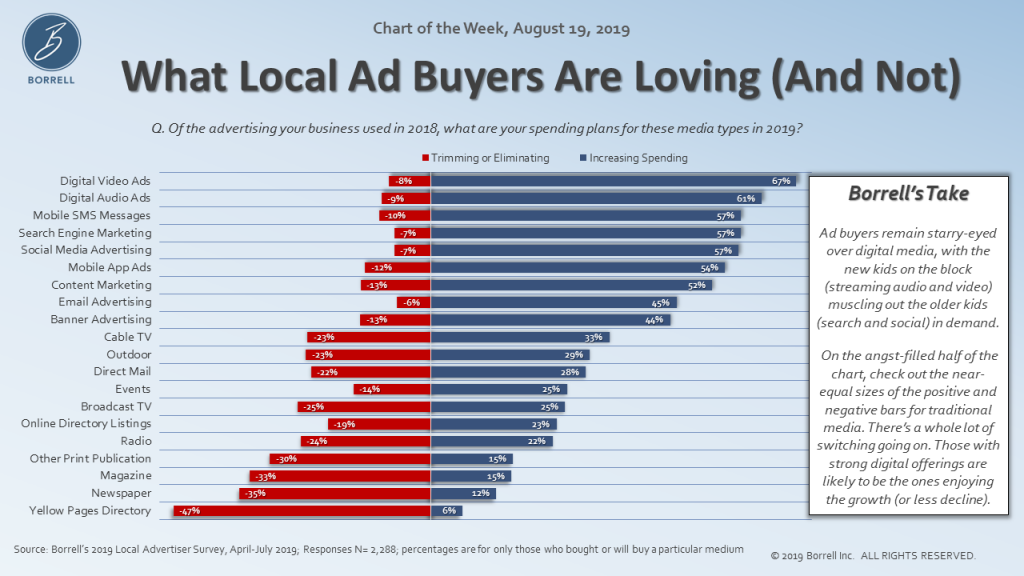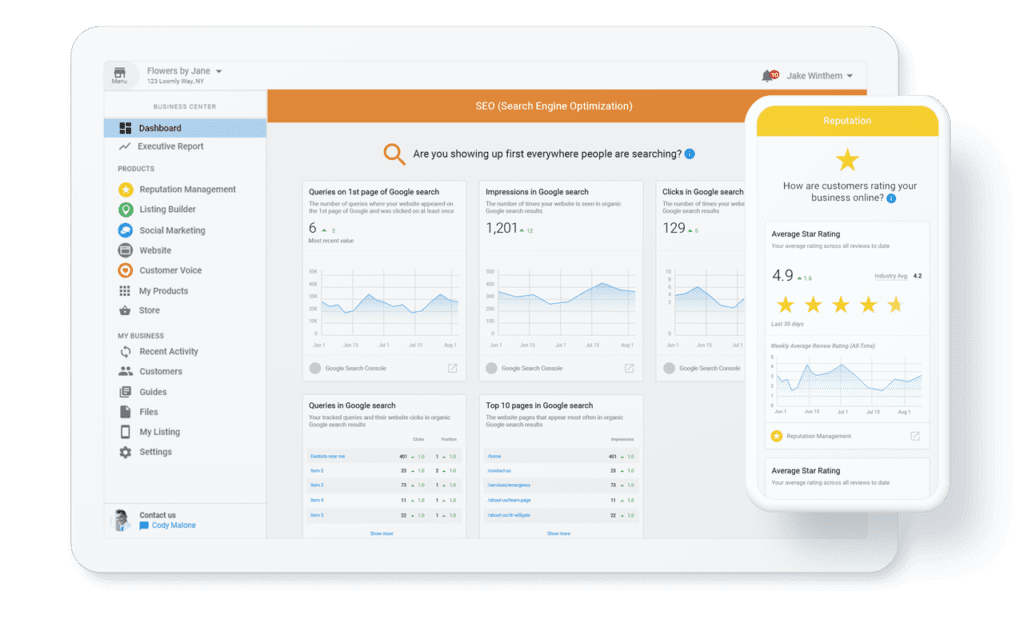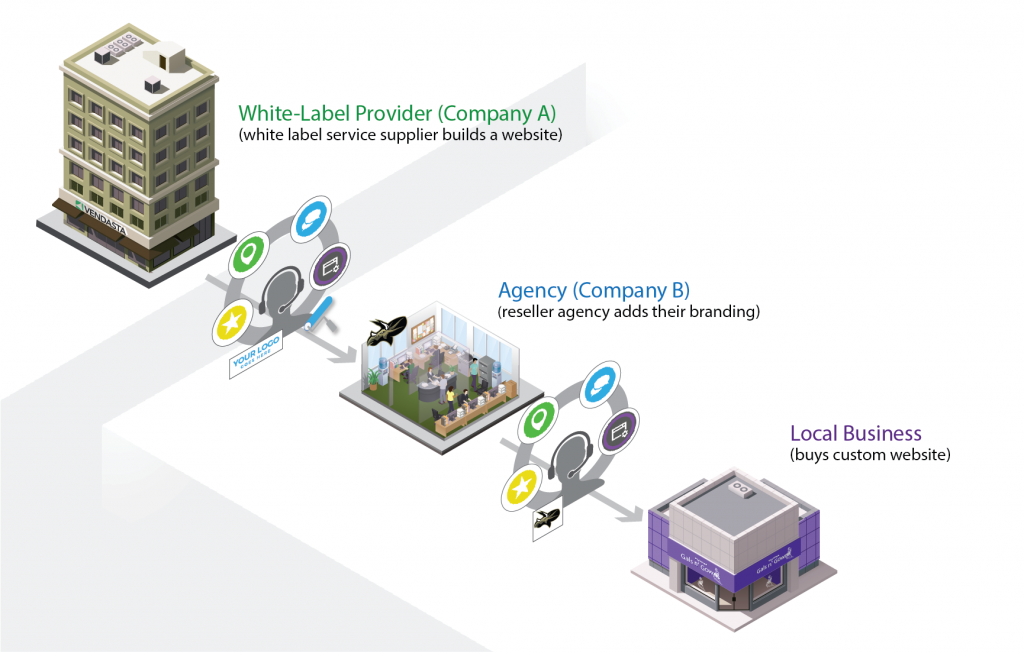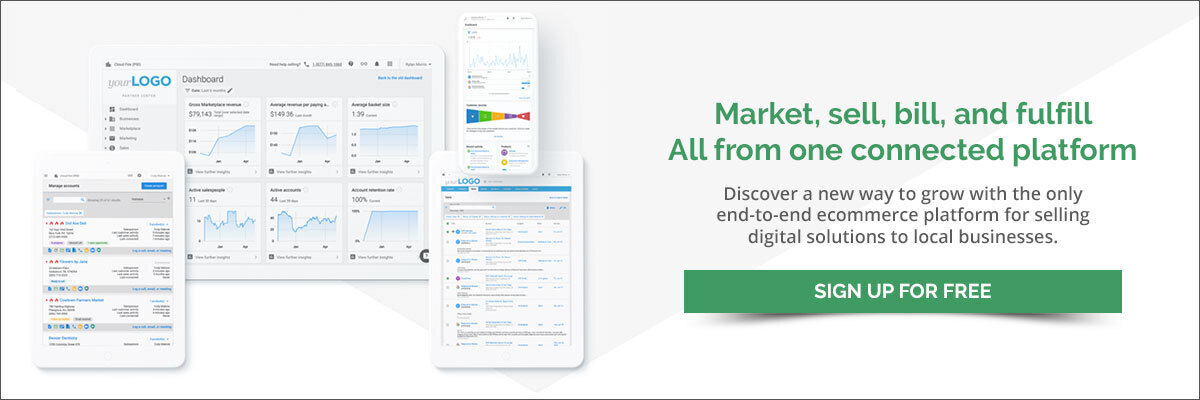Challenges TV Companies Face (and How to Remedy Them)
TV was once the king of all advertising. Second to none. Unparalleled. And it was a long dynasty too. But, just like Romans (and many before them), most great kingdoms eventually fall.
These are the projected ad spends for TV and digital between 2020 and 2023. TV ad spend is set to decline at a rate of 2.2% annually to $68.89B by 2023, while digital channels are projected to grow from $129B to $161B by 2023.
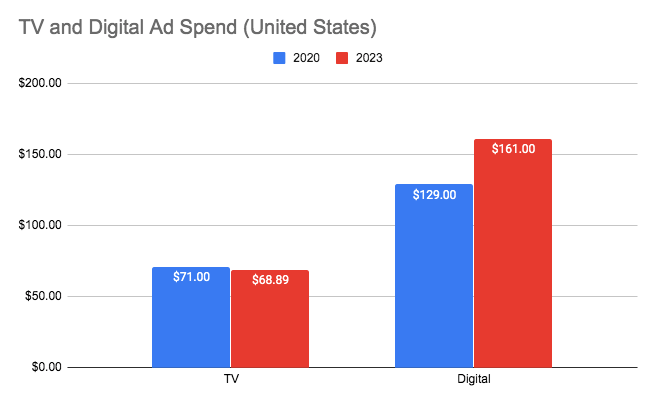
Source: eMarketer
Great kingdoms fall, or they evolve.
The British monarchy has already survived 1500 years. Today’s monarchy has but remnants of the characteristics that comprised 500 AD Britain. Today’s monarchy has evolved with the technological and socio-cultural movements to become an institution that is more strongly aligned with the values of the modern day masses.
In other words, TV isn’t going away. However, the growing opportunity in digital presents a pristine opportunity for TV companies to mitigate declining ad revenue and launch powerful new digital revenue channels.
Table of Contents
Why You Should Add Digital Marketing to TV
Benefits of Digital
TV Challenges When Selling Digital (And How to Overcome Them)
1. Training the sales team to sell digital
Remember, constant learning is more important than ever before
Then, change your perspective
Make resources available
2. Motivating product uptake with clients
The spillover effect
It’s about data leverage
3. Heavy digital presence and competition in your market
Opportunity
Advantage
The problem of presence
4. High cost of acquisition
Why You Should Add Digital Marketing to TV
In TV, you’re in the business of selling ads that’ll drive leads and sales to your customer’s business. The core concept of selling digital remains exactly the same, just through a different medium.
TV companies are in a unique position to cover even more of the market and provide a comprehensive solution to customers by combining core competencies with a digital approach. In fact, How Advertising Works Today found that “unified cross-media campaigns were on average 57% more effective than those that aren't.”
And according to Borrell Associates, it’s what local ad buyers want to invest in. This chart shows that 25% of local respondents in this 2018 study were trimming their TV spending in 2019, while roughly 57% planned to increase spending across almost a dozen digital channels.
However, the opportunity is real for TV. In fact, TV brands are actually better poised to become cross-media providers for than most competing marketing agencies. Consider that most agencies cannot easily offer traditional media solutions (like TV), without partnering with someone like you. However, with the right white-label partner, you can easily plug and play new digital solutions and build a comprehensive marketing funnel for your clients.
Benefits of Digital
- Your audience is online: According to the global web index, digital consumers are now spending 6 ¾ hours a day online, with 51% of that time spent via mobile device, and 2.2 of those hours being spent on social media alone. Consumers have reduced TV consumption in favour of more mobile driven alternatives, creating a lucrative opportunity for your clients to bridge the two platforms.
- Tracking and reporting with ease: By nature, digital solutions enable much more accurate tracking and proof of performance reporting than traditional counterparts. TV performance can be difficult to report on, so digital solutions can make your offering more tangible in the eyes of your clients. In fact, Vendasta’s Churn Study demonstrated that SMBs who receive regular proof of performance reports have a 38% increased retention rate compared to SMBs who do not.
- Do more with less: That's the power of automation. Cross-media campaigns that may appear to be very high involvement might actually be as simple as a couple clicks. For example, email campaigns for clients can be triggered automatically, product upgrades completed entirely online, etc.
- Ability to personalize: Market segmentation on TV ads is limited to timing and programming, but through social media and search solutions, you can perform more extensive segmentation for your clients.
- And most importantly, the businesses that you sell to NEED digital solutions. They’ll either get them from you or else the marketing agency down the street, so you may as well grow your revenue in the process.
TV Challenges When Selling Digital (And How to Overcome Them)
This all sounds great, but selling digital isn’t (quite) as simple as flipping a switch and watching the cash fly in. Your sales reps will need training to understand new solution sets, you’ll have new competitors in the digital space, regulating cost of acquisition (CAC) might be a challenge, and then there’s always the matter of fulfilling on new solution sets.
Here are the top challenges as well as key sales insights for conquering them:
1. Training the sales team to sell digital
You likely have some very talented and very experienced sales reps on your roster. However, if TV is their domain, learning a new industry can be a tall task and be high cost to your organization.
There’s no doubt, the digital marketing world is complex and ever-changing. For those with decades of expertise within the likes of TV, radio, or newspaper advertising, learning a new industry with new sales tactics and pipeline dynamics can be daunting. Fortunately, we can help.
Remember, constant learning is more important than ever before
According to David Little of Comporium, training—and digital training—is the cornerstone of success when embracing the digital market:
"It really comes down to technology. It comes down to utilizing the tools that we have through e-learning, sales training, presentation materials. You really need to be able to show the sales reps that you have the ability to support them, and then you need to hold them accountable."
Then, change your perspective
Our own CRO, George Leith notes that it’s often a shift in perspective that’s required to succeed in digital selling today:
"It is the salesperson that turns themselves into a consultant, that does constant learning, they are the ones that are going to be winning, and we're seeing them win today."
Product pushing isn’t going to close the deal in digital. Opportunity is ripe for the sales rep that can actively look to diagnose problems and pair them with solutions. Training on consultative selling will be the key to unlocking accelerated sales successes.
Make resources available
There’s a limit to the hand holding you can provide your reps before it becomes a drain on your human capital. That’s why it’s critical to deploy learning resources outside of core training to enable reps to pursue that constant learning on their own.
Consider deploying a learning management system (LMS) for your reps so that they can pursue that constant education on their own, and have custom learning paths built for reps that may want to specialize in certain areas.
Pro Sales Tip From Aaron LeBlanc: Make it easy for your traditional sales team to be successful. Don't overwhelm them by adding too many new solutions at once. To start growing new revenue quickly, choose a few key services that add to your TV advertising, like local findability. Then layer on additional marketing and advertising AFTER they get a few wins.
2. Motivating product uptake with clients
Once you’ve established the proper training procedures, you’re going to encounter another challenge, and that is passing that education on to your clients.
Your strength: You likely have very strong client relationships built on high degrees of trust.
Your weakness: Your clients trust you when it comes to TV—because that’s your core competency, but they might be hesitant to be as trusting when it comes to new digital solutions.
The spillover effect
Marketing spillover is the effect whereby you run TV ads for a client and someone sees the ad, thinks about it for the evening, then searches for your clients company organically at work the next morning, and proceeds to make a purchase or convert on a form—so the lead manifests itself as being “organic search” in nature. The same effect can result from paid social media ads.
Marketing spillover is a beautiful thing because it speaks to the power in multi-platform marketing, but it’s also terrifying—because it is nearly impossible to quantify. But the reality is simple: spillover is nearly impossible to quantify when running TV alone, but it is much easier to interpret through cohesive, multi-platform campaign offerings.
“Advertising is purchased to increase sales. Businesses spend money on ads because they want awareness and leads. They want to increase the top line. If you are an Auto Dealer, manufacturers mandate that you must spend 50-60% of your budget on digital. As a TV company, that’s 50-60% of your clients’ budgeted spend that you are giving up out the back door—or you can make it part of your stack of solutions and grow both your revenue, and your clients’ bottom line.”
It’s about data leverage
TV advertising is effective, of that there is no doubt. The advantage for clients in adding digital is:
- The hyper targeting potential through tactics like geofencing on geographic locations
- Sophisticated ROI tracking through hard measures on impressions (broken down by channel), actions taken (clicks, directions, etc.) and cost per lead (CPL).
Multi-channel marketing is the gateway to increased ad performance, and that’s where you can take the upper hand over pure-digital agencies. Besides, your business clients will love the ability to see precisely how their advertising dollars are working for them—each step of the way.
Pro Sales Tip From Aaron L.:Almost all TV buyers are buying digital, yet almost none of them are buying digital from their TV ad providers. If you aren’t serving your clients what they want and need, they will take a season off radio and never be back.
3. Heavy digital presence and competition in your market
First you had other TV networks to compete with, now we’re saying that you need to enter a new market with a new host of competitors. So, why on earth would you want to do that?
Opportunity and advantage.
Opportunity
There are 21,034 advertising agencies in the US that have generated ~$20 billion of revenue in 2019. That is but a fraction of the $129 billion of digital spend that was eclipsed over the past year. That means that these agencies are leaving an additional $100B+ in revenue on the table.
But who’s claiming that revenue if not agencies?
It’s traditional media companies like yours that have had the foresight to predict industry trends, and add digital solutions to their existing offerings.
Advantage
Of these 21,034 digital advertising agencies in the US, there is not one of them that can easily enter the TV space without major disruption to their core business. But let’s turn the tables—as an established TV company, white-label reseller models enable you to provide digital advertising solutions with ease.
Here’s how white-label models can work for TV companies:
- A white-label provider develops digital marketing software to be resold by companies like yours.
- A reseller (TV brand) pays a wholesale rate on new digital solutions, and then marks the software up to their desired price, puts their branding on it, and sells it to their business clients.
- Your clients benefit from a more comprehensive service provider and you simultaneously grow your bottom line through new revenue streams.
Check out Vendasta’s white-label platform!
Now, let’s jump ahead six months, and you are now a fully integrated digital-TV ad provider. Prospects in your market will choose you every time because you can offer a more immersive customer experience and more solutions than any of the digital agencies in your market. Existing clients will stay with you because you can manage their entire funnel.
The problem of presence
Okay, okay, but with 21,034 digital agencies in the states, and 1,761 TV stations, how do you compete on your marketing and sales?
First, you should look to partner with a white-label provider that can also help you with training and selling of the new digital solutions.
Next, you need to evaluate how you stack up against others in your market, and craft a pitch around that:
"You've got to recognize where you are against your competition. Are you willing to make that change? What opportunity will that bring you? Then look at your sales process and how you engage with your customer and what do you need to do differently if you can't just literally pull your product out of a bag and do a pitch."
Pro Sales Tip From Aaron L.: Leverage your existing relationship with clients to expand and grow. TV companies have two main advantages with existing clients: they have built trust with the local advertiser, and have helped them build traditional media expertise. It’s time to leverage that relationship for more business.
4. High cost of acquisition
This is actually a common misconception. If done properly, deploying digital in the TV space will actually reduce your overall cost of acquisition (CAC).
Average CAC is actually on the rise in TV, and this is a byproduct of the 25% of local ad buyers that are actively trimming their TV ad spend. This means less spending from regular clients, or lost accounts entirely. And where are these accounts and these budgets going? To the digital marketing agency down the road.
The average CAC of a marketing agency is actually among the lowest in the B2B landscape, clocking in at $141. And we know that the ideal LTV (lifetime value) to CAC ratio is 3:1, which means that these agencies only need to earn $423 per account to sustain growth. That could be the cost of a couple props for a single TV ad. BUT, as a TV company, you are going to have a hard time hitting this CAC—at least initially.
The challenge for TV brands is around familiarity with digital solutions and building a unique selling proposition at the intersection of digital and TV. Here’s the thing: when you sell TV advertising space, your clients can turn on the TV and see their ads at work. When you sell your clients new digital solutions like a listing sync service or reputation management—they may not fully understand the solution and are having to trust you that the magic you claim to be performing is actually happening (often behind the scenes).
The sales approach has to evolve with your positioning. Here are some of the keys:
- Focus on client education first
- Practice consultative sales techniques
- Talk about the spillover effect
- Emphasize on the targeting capabilities in digital
- Prove your combined performance
"Don't go in the door expecting to make a sale on the first call today when it comes to digital. There are just so many different opportunities, different services, so many different value points that those different products bring, that if you go in today and try to sell somebody something in the digital space today and you haven't taken the time to try to sit down and understand their business and what they're trying to accomplish, where they're having struggles, then you're going to lose all respect with that customer and they're going to see you truly as a pitch man."
Pro Sales Tip From Aaron L.: Today, TV has a growing cost of acquisition because local advertisers and large advertisers both demand new solutions. Check out our recent article on lowering CAC to learn more on how to deal with this.
Mixing TV with Digital
As we saw earlier, TV ad spends have matured and are currently declining in the US. Furthermore, at least one quarter of the market are actively trimming TV budgets, so it will only become more difficult to sustain market shares with TV alone. However, with 32 billion in new digital opportunity forecasted over the next 4 years, there is a massive opportunity for TV companies to generate new lines of revenue.
It’s also an equation of product diversification. A recent Vendasta study on client retention determined the following:
- Selling your clients a single solution will only yield a client retention rate of 30% over the span of 2 years.
- Adding an additional solution to that offering will drive that retention rate up to 50% over 2 years.
- Selling that same client 4 products will yield a retention rate of 80% over the same timespan.
Your existing clients are buying digital because they need it, your prospects are looking for digital because they need it too. When a local business opens their doors, they have to get listed so that people can find them, they need a website so people can get to know them, they need to build a reputation so people can trust them, and they need social media so that they can stay relevant in the community.
“There's a lot of advertising spillover. When a business advertises on TV, it creates local consumer engagement for the business on Google. The consumer does not usually convert on the TV ad or give a phone call right away. They store that information in the top of their mind for later. So the business needs to be found online because that’s where the consumer will ultimately make an action. What’s more, the business needs to have a good reputation and website - or they will lose the customer at the front door.”
Are you going to seize this opportunity?
Conclusion
Digital combined with TV is the way forward.
But, digital can’t help you blaze a bold new trail from a seat on the bench. You have to be fully invested in completing the digital transformation if you want to grow revenue well into the next decade.
Check out the Nine White-Label Solutions for TV or hop on a demo to learn more about going digital, and how Vendasta can be a strategic partner in your digital transformation through white-label solutions, fulfilment, and a marketplace of 100+ instant-on digital solutions.


